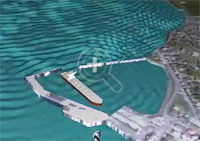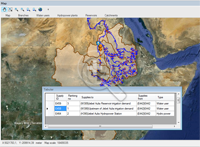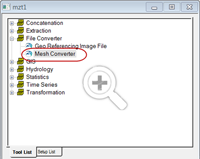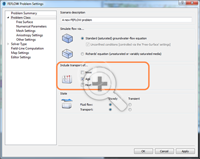Monday, 2 December 2013
Previews of MIKE by DHI Release 2014
Approximately once a year, we release a new version of our MIKE by DHI software - and this year is no exception. We would like to reveal herewith a preview of some of the new and exciting features to be released in December. We hope these new features will improve your experience with our software products, regarding usability, productivity as well as enhanced applications.
New possibilities of including moving objects in your animations
Ever wanted to add moving objects to your animations? This is possible with Release 2014.
In the September issue of this newsletter, we included a preview of new features in MIKE Animator Plus in Release 2014. In this issue, we would like to show you an example of the possibilities of this new development.
With MIKE Animator Plus, you can create visual animations to present you model results – and as something new, you will be able to include visualisation of solids. Through the inclusion of solids, you can improve your animations significantly by enhancing realism and recognition of locations, for example by including fixed elements like buildings and dams or moving elements like ships. Release 2014 will support the placement of solids inside the model domain and allow them to move, which means that a ship can be sailing as part of the animation.
MIKE HYDRO Basin: Global prioritisation of water users
MIKE HYDRO Basin is our new generation of integrated river basin analysis software for water resources planning and management.
MIKE HYDRO Basin was introduced with the current release 2012, containing a large number of features relevant for integrated river basin management applications. Developments continue for MIKE HYDRO Basin and the new release will introduce another very interesting new feature to modellers of river basin water allocation schemes and resources management; Global Prioritisation.
With this new feature, it is now possible to include a user defined prioritisation of water users within the basin model - regardless of their geographical location within the basin. Thus, it highly increases the applicability of MIKE HYDRO Basin for specific types of water resources management applications.
The global prioritisation of water users are defined through ‘Ranking’ number definitions, where water consumers are assigned an individual ranking number. The ranking numbers are used during simulation to prioritise consumers, in case of water shortage, in order to accommodate the water demands for these - taking into account that some users have a higher priority than others.
Mesh Generation: A new tool for creating flexible meshes from dfs2 files and other sources
The combination of high flexibility of flexible meshes (FM) and impressive performance improvements, introduced in the latest releases of MIKE by DHI, make the use of FM versions of MIKE 21, MIKE 3 and MIKE FLOOD even more attractive. Improvements in recent releases include, amongst others, the introduction of shared memory based parallelisation, porting of simulation engines to LINUX and, in Release 2014, supporting Graphical Processing Units (GPUs) for MIKE 21 HD FM.
In order to assist those, who want to transfer existing models or bathymetries into the FM system, Release 2014 will contain a new tool, aimed to convert bathymetries in other formats into FM format.
The new Mesh Converter is included in the MIKE Zero Toolbox and supports DHI’s own format from the ‘classic’ modelling series, dfs2 as well as some external formats (ADCIRC, SMS, TUFLOW). The process is quick and easy and produces an equal bathymetry in FM format, which can then be modified using all the existing editing facilities of MIKE Zero’s Mesh Generator.
New features in FEFLOW 6.2
FEFLOW 6.2 offers a number of new features to enhance your groundwater modelling work.
Storage Capture/Release is a new component in the Rate Budget and Period Budget Panels for flow and transport in FEFLOW 6.2. With this new component, you can clearly separate storage change and solution error in transient models.
Increased performance with new MIKE 1D features in MIKE URBAN
Strengthening wastewater modelling projects with new features in WEST 2014
We are also pleased to inform you that Release 2014 of WEST will include a plant wide model (PWM) for simulating nutrient removal activated sludge systems.
The plant wide model is developed jointly by our WEST Development Centres, the Universities of Cape Town (UCT) and kwaZulu-Natal in South Africa.
Approximately once a year, we release a new version of our MIKE by DHI software - and this year is no exception. We would like to reveal herewith a preview of some of the new and exciting features to be released in December. We hope these new features will improve your experience with our software products, regarding usability, productivity as well as enhanced applications.
New possibilities of including moving objects in your animations
Ever wanted to add moving objects to your animations? This is possible with Release 2014.
 |
| Click here to view an example of the possibilities of this new feature. |
With MIKE Animator Plus, you can create visual animations to present you model results – and as something new, you will be able to include visualisation of solids. Through the inclusion of solids, you can improve your animations significantly by enhancing realism and recognition of locations, for example by including fixed elements like buildings and dams or moving elements like ships. Release 2014 will support the placement of solids inside the model domain and allow them to move, which means that a ship can be sailing as part of the animation.
MIKE HYDRO Basin: Global prioritisation of water users
MIKE HYDRO Basin is our new generation of integrated river basin analysis software for water resources planning and management.
MIKE HYDRO Basin was introduced with the current release 2012, containing a large number of features relevant for integrated river basin management applications. Developments continue for MIKE HYDRO Basin and the new release will introduce another very interesting new feature to modellers of river basin water allocation schemes and resources management; Global Prioritisation.
With this new feature, it is now possible to include a user defined prioritisation of water users within the basin model - regardless of their geographical location within the basin. Thus, it highly increases the applicability of MIKE HYDRO Basin for specific types of water resources management applications.
The global prioritisation of water users are defined through ‘Ranking’ number definitions, where water consumers are assigned an individual ranking number. The ranking numbers are used during simulation to prioritise consumers, in case of water shortage, in order to accommodate the water demands for these - taking into account that some users have a higher priority than others.
Mesh Generation: A new tool for creating flexible meshes from dfs2 files and other sources
The combination of high flexibility of flexible meshes (FM) and impressive performance improvements, introduced in the latest releases of MIKE by DHI, make the use of FM versions of MIKE 21, MIKE 3 and MIKE FLOOD even more attractive. Improvements in recent releases include, amongst others, the introduction of shared memory based parallelisation, porting of simulation engines to LINUX and, in Release 2014, supporting Graphical Processing Units (GPUs) for MIKE 21 HD FM.
In order to assist those, who want to transfer existing models or bathymetries into the FM system, Release 2014 will contain a new tool, aimed to convert bathymetries in other formats into FM format.
The new Mesh Converter is included in the MIKE Zero Toolbox and supports DHI’s own format from the ‘classic’ modelling series, dfs2 as well as some external formats (ADCIRC, SMS, TUFLOW). The process is quick and easy and produces an equal bathymetry in FM format, which can then be modified using all the existing editing facilities of MIKE Zero’s Mesh Generator.
New features in FEFLOW 6.2
FEFLOW 6.2 offers a number of new features to enhance your groundwater modelling work.
Groundwater age calculation in FEFLOW 6.2
Groundwater Age is a new type of problem class, similar to mass or heat transport. With this, many questions can be easily answered, such as:
- How long is the average underground travel time of water pumped at a well?
- What‘s the percentage of bank filtration at the supply wells?
- What‘s the age and remaining travel time of groundwater at a certain location?
Storage Capture/Release is a new component in the Rate Budget and Period Budget Panels for flow and transport in FEFLOW 6.2. With this new component, you can clearly separate storage change and solution error in transient models.
Increased performance with new MIKE 1D features in MIKE URBAN
In 2012, we introduced a new generic 1D numerical engine for MIKE by DHI products. With the upcoming release of MIKE URBAN 2014, a number of new features for MIKE 1D will be available such as:
- coupling to MIKE SHE
- options for Advection-Dispersion modelling
- result presentation in MIKE URBAN
- and many more…
Strengthening wastewater modelling projects with new features in WEST 2014
Our WEST software package, for modelling wastewater treatment plants, has quickly established itself as an important product in the MIKE by DHI family with a growing number of users all over the world. Release 2014 includes several important new features, including:
- New Report Generator, which enables the user to automatically create reports containing graphs and data pertaining to a project in a variety of formats including: project information, plant layout, plots and tables.
- Integrated urban water system (IUWS) libraries, making WEST a powerful tool for identifying synergies and to globally optimise the wastewater system performance on a catchment scale.
We are also pleased to inform you that Release 2014 of WEST will include a plant wide model (PWM) for simulating nutrient removal activated sludge systems.
The plant wide model, ‘PWM_SA’, is a three phase model for the simulation of nutrient removal activated sludge systems coupled with the anaerobic (organisms independent of oxygen), aerobic (organisms dependent on oxygen) and anoxic-aerobic digestion of sewage sludge. This includes waste activated sludge produced by biological excess phosphorus removal plants. The model is based on strict material mass balance and is prepared by linking:
- a variation of ASM2 for activated sludge nitrogen and phosphorus removal and aerobic or anoxic–aerobic digestion
- a variation of the UCT anaerobic digestion model.
The plant wide model is developed jointly by our WEST Development Centres, the Universities of Cape Town (UCT) and kwaZulu-Natal in South Africa.
Blog Pages
Blog Archive
- 2016 (1)
- 2015 (9)
- 2014 (56)
-
2013
(49)
-
December(11)
- Season's Greetings
- RELEASE NEWS: MIKE by DHI 2014
- COMMENT: Serious Water Allocation Games (New Video)
- NEWS: Latest Stories
- NEWS: New Software Catalogue 2014
- NEWS: New Courses & Events Calendar 2014
- COMMENT: MIKE 21/3 FM Particle Tracking
- TIPS: MIKE to Google Earth
- RELEASE NEWS: Countdown to MIKE by DHI 2014 (Part 3)
- COMMENT: Detailed FEFLOW Tutorials (New Videos)
- NEWS: Latest Stories (Newsletter Roundup)
- November(6)
- August(2)
- July(9)
- June(1)
- May(4)
- April(2)
- March(6)
- February(5)
- January(3)
-
December(11)
- 2012 (52)
- 2011 (29)
- 2010 (10)
- 2009 (2)
Blog Archive
-
▼
2013
(49)
-
▼
December
(11)
- Season's Greetings
- RELEASE NEWS: MIKE by DHI 2014
- COMMENT: Serious Water Allocation Games (New Video)
- NEWS: Latest Stories
- NEWS: New Software Catalogue 2014
- NEWS: New Courses & Events Calendar 2014
- COMMENT: MIKE 21/3 FM Particle Tracking
- TIPS: MIKE to Google Earth
- RELEASE NEWS: Countdown to MIKE by DHI 2014 (Part 3)
- COMMENT: Detailed FEFLOW Tutorials (New Videos)
- NEWS: Latest Stories (Newsletter Roundup)
-
▼
December
(11)
Labels
15th MIKE by DHI UK User Group Meeting
(7)
16th MIKE by DHI UK User Group Meeting
(18)
2014 MIKE by DHI UK Symposium
(7)
2015 DHI UK and Ireland Symposium
(2)
2015 DHI UK Symposium
(2)
2015 MIKE by DHI UK Symposium
(2)
2D modelling
(1)
64-bit
(1)
ABM Lab
(4)
All-Energy
(1)
Aqua Republica
(1)
aquaculture
(1)
bathing water quality
(4)
Bird Collision
(1)
Blog Admin
(1)
Breach Assessment
(2)
Breach Modelling
(3)
Burrator Historic and Natural Environment Project
(1)
Burrator Reservoir
(1)
Catchment Management
(3)
catchment modelling
(1)
Catchment Systems
(1)
Central Modelling Platform
(1)
CIWEM
(2)
Cliff Recession
(1)
Climate Change
(5)
Climate Change Policy
(1)
Climate Change Scenario Modelling
(1)
Climate Change Tool
(4)
Cloud Computing
(1)
coastal erosion
(1)
coastal inundation
(1)
coastal modelling
(2)
Coastal Oceanography
(1)
Computer Aided River Management
(1)
Conferences
(2)
Contaminant Transport
(1)
CORFU
(3)
coupled groundwater and ecological models
(1)
coupled hydrology-hydraulic modelling
(1)
Coupled Models
(2)
CPU
(1)
cyclones
(1)
Dam break
(3)
data sharing
(1)
debris factor
(1)
Defra
(1)
DEMO
(4)
Devon
(2)
Dewatering
(1)
DHI
(163)
DHI UK & Ireland Symposium 2016
(1)
Dike Structure
(1)
Download
(1)
Dredging
(2)
Dune Erosion
(1)
ECO Lab
(10)
Ecological modelling
(5)
Ecosystems
(2)
EIA
(1)
Environment Agency
(2)
Environmental Engineering
(1)
Environmental Management
(1)
EU Floods Directive
(1)
European Overtopping Manual
(1)
EuroTop
(1)
FD2320
(1)
FD2321
(1)
Feedback
(1)
FEFLOW
(24)
FEFLOW 2012
(3)
FEFLOW 2015
(2)
FEFLOW Essentials
(2)
FEFLOW User Conference
(1)
flash floods
(1)
Flexible mesh
(7)
Flood and Water Management Act 2010
(1)
Flood Damage Assessment
(2)
Flood Defences
(3)
flood depth
(1)
Flood Forecasting
(6)
Flood Impact Assessment
(1)
Flood Modelling
(10)
Flood Resilience
(3)
Flood Risk
(6)
Flood Risk Assessment
(5)
flood risk management
(1)
Flood Risk Management (Scotland) Act 2009
(1)
Flood Risk Regulations 2009
(1)
Flood Risks to People
(1)
flood warning
(1)
flood warning systems
(1)
Flooding
(15)
Floodplains
(1)
Fluid mechanics
(1)
forecasting
(3)
Forum
(1)
FRA
(1)
games
(1)
Geothermal energy
(1)
GIS
(1)
Global Tide Model
(1)
Google Earth
(1)
GPU
(3)
Ground Source Energy
(3)
Groundwater
(12)
Groundwater Modellers Forum
(4)
Groundwater Modelling
(5)
Guidance
(4)
Hazard Mapping
(4)
Hazard Rating
(1)
High Performance Computing
(1)
Hotfixes
(1)
HPC
(1)
hydraulics
(2)
ICE
(2)
ice flooding 2013
(3)
ICE Flooding 2014
(1)
ICFR
(2)
Integrated 1D-2D pollutant transport modelling
(1)
Integrated Catchment Management
(8)
Integrated Catchment Modelling
(3)
integrated modelling
(5)
Integrated Surface and Groundwater
(9)
Integrated Water Management
(5)
Interactive Game
(1)
International Conference on Flood Resilience
(2)
Ivybridge
(1)
land use changes
(1)
Licensing
(1)
Linux
(1)
LITPACK
(4)
Managed Aquifer Recharge
(1)
Manning's n
(1)
MAR
(1)
Marine Monitoring
(1)
Marine Renewable Energy
(8)
marine water quality
(1)
Maritime Archaeological Modelling
(1)
MIKE 11
(12)
MIKE 21
(44)
MIKE 21 BW
(3)
MIKE 21 FM
(14)
MIKE 21 FMHD
(1)
MIKE 21 FMPT
(1)
MIKE 21 OS
(1)
MIKE 21 ST
(1)
MIKE 21 SW
(9)
MIKE 21C
(1)
MIKE 3
(14)
MIKE 3 FMPT
(1)
MIKE Animator
(3)
MIKE Animator Plus
(2)
MIKE BASIN
(3)
MIKE by DHI
(173)
MIKE by DHI 2014
(11)
MIKE by DHI 2016
(2)
MIKE by DHI UK Symposium
(1)
MIKE CUSTOMISED by DHI
(33)
MIKE FLOOD
(32)
MIKE FLOOD AD
(2)
MIKE HYDRO
(1)
MIKE HYDRO Basin
(3)
MIKE Powered by DHI
(4)
MIKE SDK
(1)
MIKE SHE
(10)
MIKE software
(1)
MIKE to Google Earth
(1)
MIKE URBAN
(13)
MIKE Zero
(1)
Mine Workings
(2)
Miniature Sensors
(1)
Mining
(2)
Mooring Forces
(1)
Morphological Change
(2)
NAM
(1)
News
(15)
Newsletter
(10)
Numerical modelling
(1)
Offshore Wind Farms
(4)
Oil Spill
(1)
Oil Spill Modelling
(4)
overtopping
(3)
Papers
(1)
parallelisation techniques
(1)
Particle Tracking
(1)
Planform Change
(1)
Plymouth University Marine Building
(1)
Porous Media
(1)
PREPARED
(1)
Presentations
(1)
productivity tools
(2)
Professor Kathrine Richardson
(1)
Queen’s University Belfast
(3)
rainfall data
(1)
rainfall dependent infiltration
(1)
rainfall radar
(4)
RDI
(1)
Real time control
(5)
Real-time
(9)
real-time control
(1)
real-time forecasts
(7)
Release 2011
(8)
Release 2012
(13)
Release 2014
(7)
Release 2016
(1)
Renewable energy
(12)
Research
(1)
Reservoir Inundation Modelling
(1)
River Modelling
(4)
River Monitoring
(2)
river restoration
(1)
Roughness
(1)
Rural Land Management Change
(3)
SaaS
(1)
Scour
(2)
scour risk
(1)
Sediment Transport
(4)
Serious Games
(1)
Service Packs
(9)
Sewerage
(1)
Shellfish Waters Directive
(1)
shellfisheries
(1)
shoreline evolution
(1)
slow response runoff modelling
(1)
Software
(7)
Software as a Service
(1)
Software Development Kit
(1)
Software Updates
(9)
South West Lakes Trust
(1)
SP2
(1)
Spectral Wave
(1)
Spillway
(1)
Stakeholders
(1)
Steve Flood
(1)
storm surges
(2)
Storm Swell
(1)
storm water management
(1)
Structures
(1)
SuperGen UK Centre for Marine Energy Research
(1)
Support
(9)
Surface Water Flooding
(4)
Surface Water Management
(3)
Teaching
(2)
THE ACADEMY by DHI
(42)
The Catchment Approach
(2)
Thermal Plume Modelling
(2)
three-dimensional hydrodynamics
(1)
Tidal and storm surge water levels
(1)
Tidal currents
(1)
Tidal Energy
(6)
Tidal Push
(1)
Tides
(3)
Tips
(4)
Training
(32)
Treatment
(1)
tsunamis
(1)
Turbines
(1)
UGM
(39)
UK Christmas Party 2014
(1)
UKCMER
(1)
University
(2)
University of Southampton
(1)
Urban Drainage
(8)
Urban Flooding
(13)
urban hydrology
(6)
User Group Meeting
(36)
User Group Meeting 2013
(7)
User Group Meeting 2014
(10)
User Group Meeting 2015
(2)
Vegetation growth
(1)
velocity of flood waters
(1)
Vessel Motion
(1)
Wastewater
(4)
Wastewater Treatment Plant
(2)
Water Allocation
(1)
Water Distribution
(1)
Water Framework Directive
(4)
Water Quality
(4)
water quality modelling
(4)
Wave Energy
(5)
Wave Overtopping
(5)
Waves
(6)
weather radar
(1)
WEST
(4)
Wetland Restoration
(1)
WFD
(3)
wind turbine foundations
(1)
Workshop
(1)
WWTP
(4)
Yelverton
(1)
Welcome to DHI UK
DHI is an independent, international consulting and research organisation with the global objective of advancing technological development and competence with respect to water, in all of its environments.
Worldwide, we offer a wide range of consulting services and leading edge technologies, software tools, environmental laboratories, and physical model test facilities, as well as field surveys and monitoring programmes. Designated as a not-for-profit organisation, DHI is able to invest a considerable portion of its resources in research and development. Today we co-operate with many Universities, and research organisations, and are recognised globally for our innovation and expertise.
In the UK, DHI offers niche or specialist consultancy services in the water and environment market to government agencies, commercial entities and selected research organisations. We fulfil a research based specialist advisor role; a ‘Consultant to the Consultants’. We also supply and support the renowned MIKE by DHI suite of integrated water modelling tools.
MIKE by DHI software is the result of years of experience and dedicated development and has, in many regions, become the standard modelling tool. It transforms our science into practice and gives you the competitive edge and, through the DHI Academy, you can rest assured that there is a local team of highly skilled experts committed to train and support you every step of the way.
MIKE by DHI truly models the world of water - from mountain streams to the ocean and from drinking water to treatment plant and beyond.
DHI Profile Video
Useful DHI Links
Available External Data
- EMODnet-Hydrography Portal
- ETOPO1 Global Relief Model (NOAA / NGDC)
- NOAA / NGDC DEM Portal (ArcIMS Map Interface)
- GMRT (Marine Geoscience Data System)
- GEBCO (BODC)
- SRTM (NASA)
- The National Map Seamless Server (USGS)
- Processed SRTM for Academic Use (CGIAR-CSI)
- ASTER (ERSDAC)
- Virtual Terrain Project
- OS OpenData (Ordnance Survey)
- Channel Coastal Observatory
- NCEP / NCAR Reanalysis (Surface Flux Data)
- Jeppesen Professional+ Vector Chart Database





